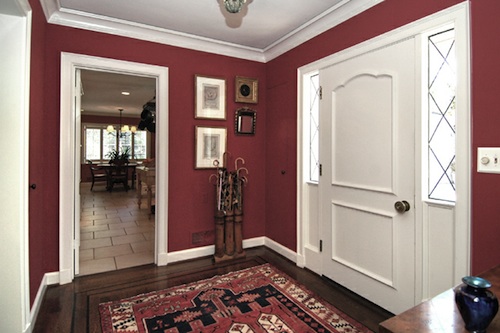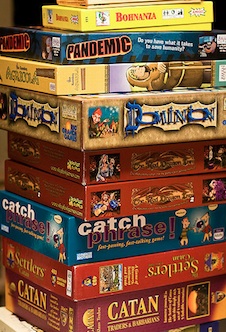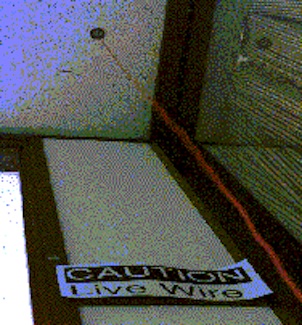Exercises
Weekly Prototyping Exercises
Exercise 1: Sketches (Wearable Computing)
The Assignment: You are to create and submit 50 sketches exploring possibilities for the design of a wearable computing technology for helping you to find your way if you should become lost. Note that while this can be a technology that would be used in an urban or suburban environment, one of the things that I'd like you to think about is how such a technology might be used in the wilderness or some other environment where one or both of the user's hands might not be available to interact directly with the technology.

Although we will not place a heavy weight on the aesthetics of your sketches when evaluating your submission, we will be looking at how effectively your sketches communicate the essence of your ideas for the technology and that there is substantive variation among your sketches. We expect that you will spend between 60 and 90 minutes working on this assignment.
Deliverable: 50 sketches on loose-leaf paper (or photocopied from your sketchbook!), suitable for presentation and design critique at the beginning of our next class meeting.
Deadline: At the beginning of class, Monday, April 16.
Evaluation Criteria: Your exercise will be scored out of a possible 150 points. Each individual sketch can earn up to three points toward your overall grade.
- 1 point for submitting the sketch
- 1 point for each sketch that effectively communicates some aspect of your proposed design
- 1 point for each sketch that illustrates some unique positioning in the design space
(That is to say that if you submit 50 sketches, you will automatically earn 1/3 of the points possible. You will only "lose" points on the assignment by submitting sketches that have no discernible communicative value or that do not significantly differ from other sketches that you submit.)
Exercise 2: Hybrid and Physical Sketches
(Ubicomp in the Home)
The Assignment: You are to create and submit 20 vanilla sketches and a combination of 3 hybrid and/or physical sketches exploring possibilities for the design of a ubiquitous computing technology that might enhance or augment the entryway of a home or apartment. Note that the focus of this assignment is to imagine new technologies that take into account how people want to experience the environment of their home and what technologies they will want to live with. It is preferable (although not strictly required) that your hybrid and physical sketches explore different points in the space of generality, narrativity, and materiality in their execution.

Note also that we asked for more plausible technologies this week, that is, think of designs that might reasonably be commercially available within the next 5-10 years (at most!).
We will begin to place increasing weight on the aesthetics of your submission, but we will still be primarily looking at how effectively your sketches communicate the essence of your ideas for your technology/technologies. We should see some degree of breadth explored through your collection of vanilla sketches, and you may either create hybrid/physical sketches of different technologies or you may capture different facets of a single idea that you are most interested in pursuing at a greater level of depth.
Deliverable: 20 "vanilla" sketches on loose-leaf paper (or photocopied from your sketchbook!) and three hybrid or physical sketches, suitable for presentation and design critique at the beginning of our next class meeting. If you create electronic artifacts, please bring hard copies to facilitate in-class discussion and as your final deliverable.
Deadline: At the beginning of class, Monday, April 23.
Evaluation Criteria: Your exercise will be scored out of a possible 150 points.
Each individual "vanilla" sketch can earn up to three points toward your overall grade, for a total of 60 points:
- 1 point for submitting the sketch
- 1 point for each sketch that effectively communicates some aspect of your proposed design
- 1 point for each sketch that illustrates some unique positioning in the design space
Each of your hybrid or physical sketches can earn up to 30 points toward your overall grade, for a total of 90 points:
- 10 points for submitting the sketch
- 10 points for each sketch that effectively communicates some aspect of your proposed design
- 10 points for each sketch that illustrates some unique positioning in the design space
Exercise 3: Storyboards
(Augmented Reality Systems)
The Assignment: You are to create and submit 6 storyboards, each a minimum of 5 frames long exploring possibilities for the design of a augmented reality system that might enhance the experience of visiting a farmer's market (or food truck gathering). Your proposed AR system should be socially appropriate for the given context, and could provide information about other people's ratings of various vendors or food stalls, information about the source/history/freshness of the products being sold, or information about the vendors and the farming or food preparation techniques that they use. Note also that at least one of your storyboards should illustrate some kind of break-down (social or technical) with the technology and show how its users would recover from this unexpected or problematic condition.

Please continue aiming to design reasonably plausible technologies, that is, think of designs that might be commercially available within the next 5-10 years.
We will continue to place increasing weight on the aesthetics of your submission, but are still looking as heavily at how effectively your sketches communicate the essence of your ideas for your technology/technologies.
Deliverable: 6 storyboards on loose-leaf paper (or photocopied from your sketchbook!), each consisting of a minimum of 5 frames, suitable for presentation and design critique at the beginning of our next class meeting. If you create electronic artifacts, please bring hard copies to facilitate in-class discussion and as your final deliverable.
Deadline: At the beginning of class, Monday, April 30.
Evaluation Criteria: Your exercise will be scored out of a possible 150 points. UPDATED: Edited to fix my apparently bad math skills.
Each individual storyboard can earn up to 25 points toward your overall grade, for a total of 150 points:
- 2 points for the clarity and aesthetics of each storyboard panel (2 points = very good effort; 1 point = not-so-great effort; 0 points = little effort reflected), for a maximum of 10 points
- 5 points for illustrating a unique story/scenario with this storyboard (relative to the other storyboards submitted)
- 10 points for the overall communicative effectiveness of the storyboard (i.e., the storyboard makes sense, the idea is clearly conveyed, a viewer would be able to understand what is happening with both the human actors--visible or implied--and with the system during each frame)
Exercise 4: Animation Sequence
(Location-Aware Systems)
The Assignment: You are to create and submit 3 animated sequences, each with a running time of approximately 5-15 seconds, exploring possibilities for the design of a location-aware system to help families to location and plan meetings with one another when split up during a day at a theme park. Your proposed interfaces and/or interaction techniques should be appropriate for a ubiquitous computing device of your own choosing (this could be an existing technology or a novel one), and you should illustrate three different use scenarios: (1) how a user would interact with your technology to search for family members; (2) how a user would interact with your technology to identify and share a future meet-up point in the park; and (3) how a user would interact with your technology to share a location-based "check in" with selected friends or family members.

Please continue aiming to design reasonably plausible technologies, that is, think of designs that might be commercially available within the next 5-10 years. Also remember that different physical contexts might necessitate the use of different kinds of location-sensing technologies, which, in turn, impact how locations are presented in a location-aware interface. You will need to decide what kind of sensing would be appropriate and reflect your decisions (explicitly or implicitly) in your animated sequences.
We will continue to place increasing weight on the aesthetics of your submission, but are still looking as heavily at how effectively your sketches communicate the essence of your ideas for your technology/technologies.
Deliverable: 3 animated sequences in WMV, MOV, MP4 (H.264), PPT, or PPTX format, with a minimum running time of 5 seconds each, suitable for presentation and design critique at the beginning of our next class meeting. You will need to bring a laptop to present your sequences to your critique group mates, or you will need to arrange (on your own) to collaborate with another class member to use their technology to present. All exercises need to be submitted electronically to both Dr. Voida and Miya (svoida@acm.org and nsylvest@uci.edu) by the beginning of class, Monday, May 14 -- you can either send your files as email attachments or send working links to your preferred cloud/web file sharing service. (It is your responsibility to make sure that linked artifacts are available for grading through Wednesday, May 16.)
Deadline: At the beginning of class, Monday, May 14.
Evaluation Criteria: Your exercise will be scored out of a possible 150 points.
Each individual animated sequence can earn up to 50 points toward your overall grade, for a total of 150 points:
- 20 points for the communicative effectiveness of each animated sequence (Does it make sense? Does it clearly communicate the proposed interface design and/or interaction technique? Would a non-expert understand what is happening throughout?)
- 10 points for the aesthetic value of each animated sequence (Does the sketch look professional and well-executed or rushed and sloppy?)
- 10 points for the originality of the proposed interface and/or interaction technique
- 5 points for the completeness of each animated sequence (Is the entire interaction illustrated, from beginning to end, without forcing a viewer to imagine or infer additional steps?)
- 5 points for an appropriate use of location-awareness technologies (Is the interaction appropriate given the known constraints of various location-awareness technologies? Is an appropriate level of location information being shared?)
Exercise 5: Video Sketch
(Mobile Gaming)
The Assignment: You are to create and submit 1 video sketch with a running time of approximately 2-4 minutes, exploring possibilities for the design of a ubicomp/mobile gaming adaptation of an existing board game, suitable for multiple players. Your game can be a literal re-interpretation of the original game, or you can create a new game that is inspired by the original, using a subset of the original game's mechanics. You may work in teams of 1-4 students to complete this assignment. All contributors will receive the same grade for their submission.

Please continue aiming to design reasonably plausible technologies, that is, think of designs that might be commercially available within the next 5-10 years. Your design should take into account the design constraints related to ubicomp technologies (e.g., location-sensing accuracy, battery life, social considerations) that we have talked about previously during the class.
We will continue to place increasing weight on the aesthetics of your submission, but are still looking as heavily at how effectively your sketch communicate the essence of your ideas for your technology/technologies.
Deliverable: 1 video sketch in WMV, MOV, MP4 (H.264), FLV, or SWF format, with a running time of approximately 2-4 minutes, suitable for presentation and design critique at the beginning of our next class meeting. All exercises need to be submitted electronically to both Dr. Voida and Miya (svoida@acm.org and nsylvest@uci.edu) before the beginning of class, Monday, May 14 -- you can either send your files as email attachments or send working links to your preferred cloud/web file sharing service.
Deadline: Before the beginning of class, Monday, May 21.
Evaluation Criteria: Your exercise will be scored out of a possible 150 points.
- 50 points for the communicative effectiveness of the video sketch (Does it make sense? Does it clearly communicate the proposed interface design and/or interaction technique? Would a non-expert understand what is happening throughout?)
- 30 points for an appropriate use of ubicomp/mobile technologies (Is the interaction appropriate given the known constraints of ubiquitous computing technologies?)
- 30 points for the aesthetic value of the video sketch (Does the sketch look professional and well-executed or rushed and sloppy?)
- 20 points for the completeness of the video sketch (Is the entire interaction illustrated, from beginning to end, without forcing a viewer to imagine or infer additional steps?)
- 20 points for the originality of the proposed interface and/or interaction technique
EXTRA CREDIT Exercise 6: Interactive Sketch/Prototype
(Ambient Displays)
The Assignment: You are to create and submit 1 interactive sketch/prototype of an ambient display that reflects the real-time value of an information source. Your ambient display can either be a physical prototype (e.g., using an Arduino board or Phidgets actuators), or it may be an information display (e.g., a full-screen visualization on your computer, representing the content that would be projected on a wall, or an implementation for an iOS or Android animated wallpaper). In either case, your interactive sketch should embody the principles of calm computing, that is, it must be suitable as a peripheral display of information and should transition between states in a gradual, non-distracting manner. You may work in teams of 1-4 students to complete this assignment. All contributors will receive the same grade for their submission.
This exercise will be an extra-credit assignment; no points will be deducted if you choose not to submit this assignment. You will be able to earn a maximum of 75 points toward your weekly exercise score, i.e., the equivalent of 1/2 the points of the other exercises, or a total of 3.125% towards your final grade. The lowest of your other exercise scores will still be dropped, in accordance with the grading overview originally provided in the class syllabus.

Deliverable: 1 interactive sketch/prototype. Any physical components of your submission should be turned in at the beginning of our next class session, and your source code (along with instructions on how to compile and run the display executable) should be compressed into a ZIP archive and submitted electronically to Dr. Voida (svoida@acm.org) by the beginning of class on Monday, June 4. You can either send your files as email attachments or send working links to your preferred cloud/web file sharing service.
I have a limited number of Phidgets InterfaceKits and servos that can be checked out for this exercise; contact me by email to schedule a check-out time at DBH 5221. (There are some fantastic examples of what you can do with Phidgets on Saul Greenberg's Phidgets gallery webpage, if you are looking for inspiration.) You are also welcome to use your own hardware or resources, if you'd prefer.
Deadline: At the beginning of class, Monday, June 4.
Evaluation Criteria: Your exercise will be scored out of a possible 75 points.
- 25 points for a complete, working sketch/prototype that correctly compiles and executes under a stock development environment and reflects the value of a real-time information source while running.
- 20 points for the communicative effectiveness of the interactive sketch/prototype (Does it make sense? Does it clearly communicate the real-time value of the information source?)
- 20 points for the aesthetic value of the interactive sketch/prototype (Does the sketch look professional and well-executed or rushed and sloppy?)
- 10 points for the originality of the interactive sketch/prototype

